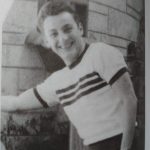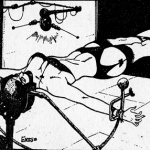The promotional website for the book Permanent Obscurity has a brief history of fetish and bondage artist Eric Stanton and his business relationship with Irvine Klaw.
Biographical facts about his life are often contradictory and murky; and sometimes he would contribute to this misinformation personally. There’s even some question of his real name: was he born “Ernest Stanzoni” as claimed in the huge Eric Kroll coffee table book? Or is his birth name “Ernest Stanten,” as claimed by Belier publisher and personal friend and associate, J.B. Rund?
Most of what I know about the sexploitation era and the subgenre of what was then labeled “bizarre,” which today would be assigned fetish culture or kink, I’ve learned through tracking Stanton. He remains, in some strange way, a central figure for me (my own personal Dante) whose life intersected with other curious characters of the day, artists and business people, gangsters and hacks … shadowy and mythologized figures I’ve come to admire and who I never grow tired of hearing about: Irving Klaw, Bettie Page, Gene Bilbrew, Lenny Burtman, Eddie Mishkin, Stanley Malkin…. And then, of course, there’s Steve Ditko, Spider-Man co-creator and Stanton’s friend-as well as his studio mate of 10 years.
(ellipsis in original)
According to this, Stanton would self-publish and self-print his own works with his own photocopier. I’ve always been interesting in the means of production and distribution for works that had such a huge influence on the history of kink, and it seems fitting that so much of it was produced on a shoestring, in a confluence between people who were seeking a market niche and people who were seeking their kink.
PS: I’d be interested to know what Ditko, known for espousing a harsh Objectivist philosophy in his work, would have made of Stanton’s fetish art. Then again, there’s something a bit kinky in Ditko’s Objectivist characters. The Question wore a rubber mask that made him look like he had no facial features at all, just smooth skin. Mr. A, an even harsher character, wore a steel helmet that gave him unmoving, impassive features, as well as steel gloves that locked on. It struck me as fitting that a character so committed to an ideology would go to such extremes in concealing his own humanity and in not having to touch the messy, complicated human world. (Both characters were the inspiration for Rorshach in Alan Moore and Dave Gibbons’ Watchmen.)



